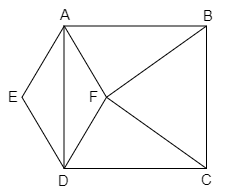
In the given figure, ABCD is a square, BCF is an equilateral triangle and AEDF is a rhombus. Find $\angle EAF$

A. $30^\circ $
B. $120^\circ $
C. $150^\circ $
D. None of these

Answer
552.9k+ views
Hint: From the figure, it is shown that $\angle AFB$ and $\angle CFD$ are right angles. As BCF is an equilateral triangle, so calculate $\angle BFC$. As we know that angles around a point add up to $360^\circ $. From this find the value of $\angle AFD$. From the properties of the rhombus, the sum of adjacent angles of the rhombus is supplementary. From this property, we will get the value of $\angle EAF$.
Complete step by step answer:
From the figure, it is clear that $\angle AFB$ and $\angle CFD$ is right angles. So,
$ \Rightarrow \angle AFB = \angle CFD = 90^\circ $
As BCF is an equilateral triangle, we know that all angles of an equilateral triangle are equal. Then,
$ \Rightarrow \angle BFC = 60^\circ $
Now, we know that all angles around a point add up to $360^\circ $. Thus at point F,
$ \Rightarrow \angle BFC + \angle AFB + \angle AFD + \angle CFD = 360^\circ $
Substitute the values,
$ \Rightarrow 60^\circ + 90^\circ + \angle AFD + 90^\circ = 360^\circ $
Add the terms on the left side,
$ \Rightarrow 240^\circ + \angle AFD = 360^\circ $
Move the angle value on the right side,
$ \Rightarrow \angle AFD = 360^\circ - 240^\circ $
Subtract the value on the right side,
$ \Rightarrow \angle AFD = 120^\circ $
Now, apply the property of rhombus states that the sum of adjacent angles of a rhombus is supplementary. So,
$ \Rightarrow \angle AFD + \angle EAF = 180^\circ $
Substitute the value,
$ \Rightarrow 120^\circ + \angle EAF = 180^\circ $
Move the angle value on the right side,
$ \Rightarrow \angle EAF = 180^\circ - 120^\circ $
Subtract the value on the right side,
$ \Rightarrow \angle EAF = 60^\circ $
Thus, the value of $\angle EAF$ is $60^\circ $.
Hence, option (D) is the correct answer.
Note: A square is a quadrilateral in which all the four sides are equal in length and all the angles are equal. All the angles are equal to 90 degrees i.e. they are right angles.
A rhombus is a type of quadrilateral in which all four sides are of equal length. Also, the diagonals are perpendicular to one another and bisect each other too.
A triangle whose all three sides are of equal length is called an equilateral triangle. The measure of each angle of a triangle is 60 degrees.
Complete step by step answer:
From the figure, it is clear that $\angle AFB$ and $\angle CFD$ is right angles. So,
$ \Rightarrow \angle AFB = \angle CFD = 90^\circ $
As BCF is an equilateral triangle, we know that all angles of an equilateral triangle are equal. Then,
$ \Rightarrow \angle BFC = 60^\circ $
Now, we know that all angles around a point add up to $360^\circ $. Thus at point F,
$ \Rightarrow \angle BFC + \angle AFB + \angle AFD + \angle CFD = 360^\circ $
Substitute the values,
$ \Rightarrow 60^\circ + 90^\circ + \angle AFD + 90^\circ = 360^\circ $
Add the terms on the left side,
$ \Rightarrow 240^\circ + \angle AFD = 360^\circ $
Move the angle value on the right side,
$ \Rightarrow \angle AFD = 360^\circ - 240^\circ $
Subtract the value on the right side,
$ \Rightarrow \angle AFD = 120^\circ $
Now, apply the property of rhombus states that the sum of adjacent angles of a rhombus is supplementary. So,
$ \Rightarrow \angle AFD + \angle EAF = 180^\circ $
Substitute the value,
$ \Rightarrow 120^\circ + \angle EAF = 180^\circ $
Move the angle value on the right side,
$ \Rightarrow \angle EAF = 180^\circ - 120^\circ $
Subtract the value on the right side,
$ \Rightarrow \angle EAF = 60^\circ $
Thus, the value of $\angle EAF$ is $60^\circ $.
Hence, option (D) is the correct answer.
Note: A square is a quadrilateral in which all the four sides are equal in length and all the angles are equal. All the angles are equal to 90 degrees i.e. they are right angles.
A rhombus is a type of quadrilateral in which all four sides are of equal length. Also, the diagonals are perpendicular to one another and bisect each other too.
A triangle whose all three sides are of equal length is called an equilateral triangle. The measure of each angle of a triangle is 60 degrees.
Recently Updated Pages
Master Class 11 Business Studies: Engaging Questions & Answers for Success

Master Class 11 Computer Science: Engaging Questions & Answers for Success

Master Class 11 Maths: Engaging Questions & Answers for Success

Master Class 11 Chemistry: Engaging Questions & Answers for Success

Master Class 11 Economics: Engaging Questions & Answers for Success

Master Class 11 Accountancy: Engaging Questions & Answers for Success

Trending doubts
What is meant by exothermic and endothermic reactions class 11 chemistry CBSE

10 examples of friction in our daily life

One Metric ton is equal to kg A 10000 B 1000 C 100 class 11 physics CBSE

1 Quintal is equal to a 110 kg b 10 kg c 100kg d 1000 class 11 physics CBSE

Difference Between Prokaryotic Cells and Eukaryotic Cells

What are Quantum numbers Explain the quantum number class 11 chemistry CBSE




